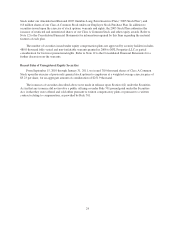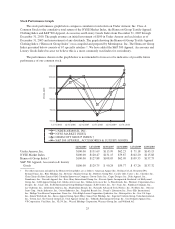Under Armour 2010 Annual Report Download - page 23
Download and view the complete annual report
Please find page 23 of the 2010 Under Armour annual report below. You can navigate through the pages in the report by either clicking on the pages listed below, or by using the keyword search tool below to find specific information within the annual report.We rely on third-party suppliers and manufacturers to provide fabrics for and to produce our products,
and we have limited control over these suppliers and manufacturers and may not be able to obtain quality
products on a timely basis or in sufficient quantity.
Many of the specialty fabrics used in our products are technically advanced textile products developed by
third parties and may be available, in the short-term, from a very limited number of sources. Substantially all of
our products are manufactured by unaffiliated manufacturers, and, in 2010, six manufacturers produced
approximately 45% of our products. We have no long term contracts with our suppliers or manufacturing
sources, and we compete with other companies for fabrics, raw materials, production and import quota capacity.
We may experience a significant disruption in the supply of fabrics or raw materials from current sources or,
in the event of a disruption, we may be unable to locate alternative materials suppliers of comparable quality at
an acceptable price, or at all. In addition, our unaffiliated manufacturers may not be able to fill our orders in a
timely manner. If we experience significant increased demand, or we lose or need to replace an existing
manufacturer or supplier as a result of adverse economic conditions or other reasons, additional supplies of
fabrics or raw materials or additional manufacturing capacity may not be available when required on terms that
are acceptable to us, or at all, or suppliers or manufacturers may not be able to allocate sufficient capacity to us in
order to meet our requirements. In addition, even if we are able to expand existing or find new manufacturing or
fabric sources, we may encounter delays in production and added costs as a result of the time it takes to train our
suppliers and manufacturers in our methods, products and quality control standards. Any delays, interruption or
increased costs in the supply of fabric or manufacture of our products could have an adverse effect on our ability
to meet retail customer and consumer demand for our products and result in lower net revenues and net income
both in the short and long term.
We have occasionally received, and may in the future continue to receive, shipments of product that fail to
conform to our quality control standards. In that event, unless we are able to obtain replacement products in a
timely manner, we risk the loss of net revenues resulting from the inability to sell those products and related
increased administrative and shipping costs. In addition, because we do not control our manufacturers, products
that fail to meet our standards or other unauthorized products could end up in the marketplace without our
knowledge, which could harm our brand and our reputation in the marketplace.
Labor disruptions at ports or our suppliers or manufacturers may adversely affect our business.
Our business depends on our ability to source and distribute products in a timely manner. As a result, we
rely on the free flow of goods through open and operational ports worldwide and on a consistent basis from our
suppliers and manufacturers. Labor disputes at various ports, such as those experienced at western U.S. ports in
2002, or at our suppliers or manufacturers, create significant risks for our business, particularly if these disputes
result in work slowdowns, lockouts, strikes or other disruptions during our peak importing or manufacturing
seasons, and could have an adverse effect on our business, potentially resulting in cancelled orders by customers,
unanticipated inventory accumulation or shortages and reduced net revenues and net income.
Our international operations and the operations of many of our manufacturers are subject to additional
risks that are beyond our control and that could harm our business.
In 2010, our apparel and footwear were manufactured by 26 primary manufacturers, operating in 22
countries. Of these, six manufactured approximately 45% of our products, at locations in Honduras, Jordan,
Malaysia, Mexico, Nicaragua, Philippines, Taiwan and Vietnam. In 2010, approximately 55% of our products
were manufactured in Asia, 25% in Central and South America, 10% in Mexico and 5% in the Middle East. In
addition, approximately 6% of our 2010 net revenues were generated through sales and licensing fees in other
foreign countries. As a result of our international manufacturing and sales, we are subject to risks associated with
doing business abroad, including:
• political unrest, terrorism and economic instability resulting in the disruption of trade from foreign
countries in which our products are manufactured;
15
























